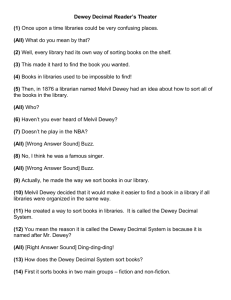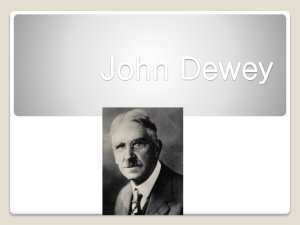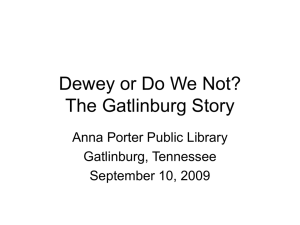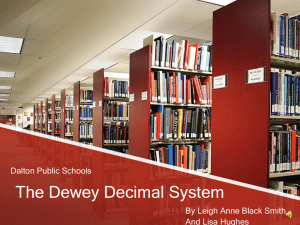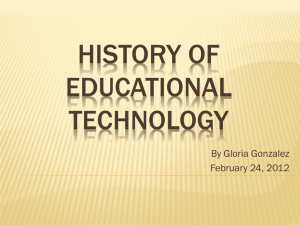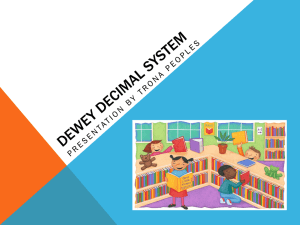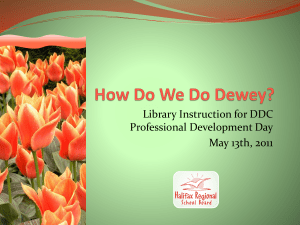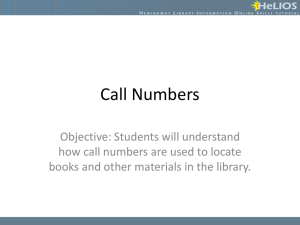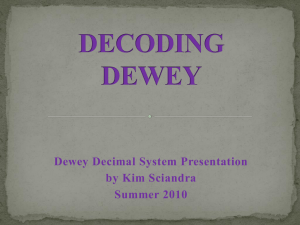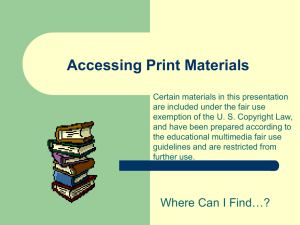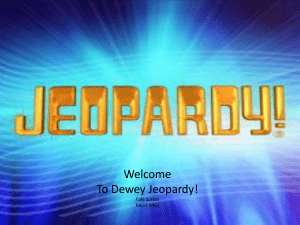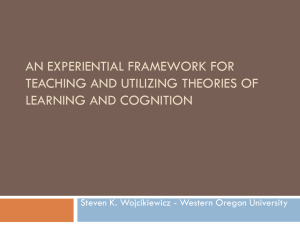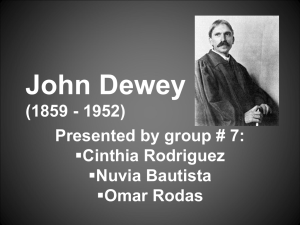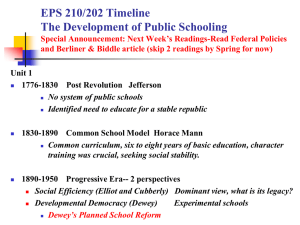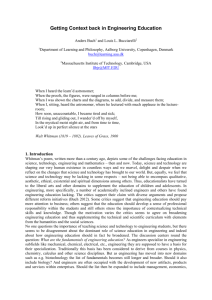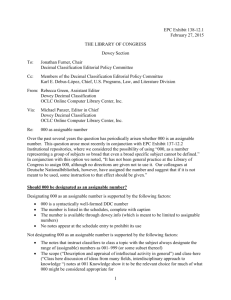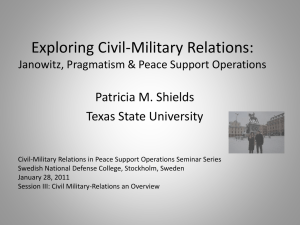The Dewey Decimal System
advertisement
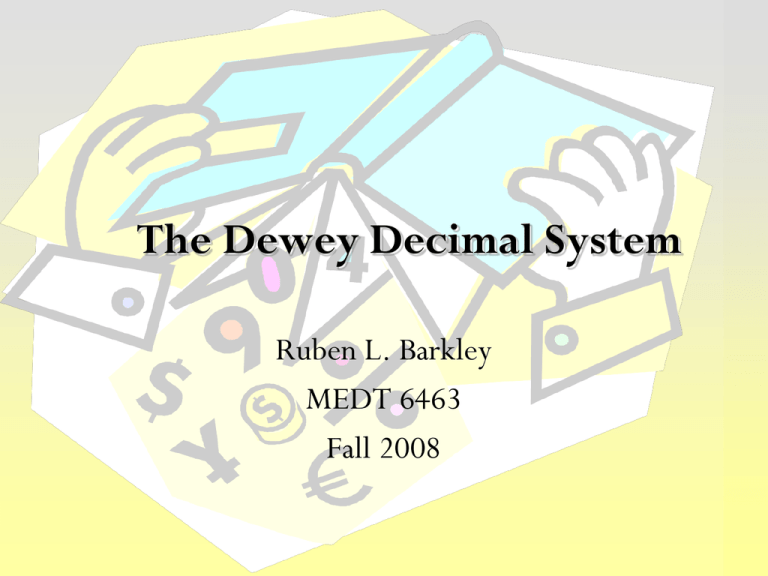
The Dewey Decimal System Ruben L. Barkley MEDT 6463 Fall 2008 Scope This presentation is designed to familiarize faculty and staff with the Dewey Decimal System by exploring… • Melville Dewey • Dewey’s classification system • Dewey’s classification structure 2 Scope Upon conclusion, viewers should be able to… • Explain Dewey Decimal Classification system • Identify 10 key classifications • Recognize Dewey Classifications based upon call numbers 3 Dewey’s Origins • Named after Melville Louis Kossuth Dewey, the father of American library science. – Born December 10, 1851 – Highly interested in simplifying spelling and classifying • Shortened his name to Melvil Dui • Invented Dewey Decimal Classification (DDC) system at the age of 21 • Changed librarianship from a vocation to a modern profession. – Helped establish American Library Association in 1876 – Founded a library school in 1883 – Co-founded and edited Library Journal 4 Dewey Defined Nonfictional classification publication system used by more than 85% of U.S. libraries. • Provides logical system for organizing each item in a library’s unique collection using 10 simple categories. • Leverages 3-digit number (Call Numbers) followed by decimal points. • Allows publication shelving by number. • Offers users familiarity and consistency in locating key materials. 5 Logical Classification System… Structure Dewey is divided into 10 main classes that cover the entire world of knowledge. Further divided into divisions With each division divided into 10 sections. DDC’s main structure is presented in summaries. 1. The first summary contains the 10 main classes; Ex: 6 of 600 represents Technology. 2. The second summary contains the hundreds division; Ex: 1 of 610 represents Medicine and Health. 3. The third summary contains the thousands section; Ex: 2 of 612 represents human physiology. Decimal points following the 3rd number for a specific degree of classification. 6 Logical Classification System… Classes 000’s General Works 500’s Science 100’s Philosophy & Psychology 600’s Technology 400’s 200’s 300’s Religion Social Sciences Language 800’s 900’s 700’s Arts & Recreation Literature History & Geography 7 What is a Call Number? 1. An alphanumeric code which identifies the shelf location of an item in the library. 2. A combination of letters and numbers assigned to each book, microform, recording or other material. 3. The letters and/or numbers used by a library to classify and arrange materials. 004 190 200 305 8 000 General Works & Knowledge Knowledge – 1.acquaintance with facts, truths, or principles, as from study or investigation; general erudition: knowledge of many things. 2.familiarity or conversance, as with a particular subject or branch of learning. 9 000 General Works & Knowledge 004 004 Describes the history of the computer; aspects of modern life in which computers play a role; the future of directions of computer technology, and cyber threats such as viruses and spyware. Presents a short history of the computer by examining the abacus and slide rule. 10 100 Philosophy and Psychology Philosophy – The rational investigation of the truths and principles of being, knowledge, or conduct. Psychology – 1. The science of the mind or of mental states and processes. 2. The science of human and animal behavior. 11 100 Philosophy and Psychology 190 Contrasts the enlightenment period in Europe, France, and America, discussing how important advances, writings, and discoveries during the era contributed through the modern world. 172 Deepak Chopra presents the argument that in order to stop war, governments must stop thinking of war as a means to peace, but peace itself as the only true way to bring harmony to the world. 12 200 Religion Religion – 1.a set of beliefs concerning the cause, nature, and purpose of the universe, esp. when considered as the creation of a superhuman agency or agencies, usually involving devotional and ritual observances, and often containing a moral code governing the conduct of human affairs. 2.a specific fundamental set of beliefs and practices generally agreed upon by a number of persons or sects: the Christian religion; the Buddhist religion 13 200 Religion 200 Over 20 essays arguing opposing sides on issues regarding religion in America. http://www.amazon.com/Religion-America-Viewpoints-WilliamDudley/dp/1565100026/ref=sr_11_1?ie=UTF8&qid=1225843446&sr=11-1 201 Closely examines religion’s role in the politics of the United States and Canada while addressing issues such as abortion, homosexuality, stem-cell research and more. 14 300 Social Sciences Social Science – 1. the study of society and social behavior. 2. a science or field of study, as history, economics, etc., dealing with an aspect of society or forms of social activity. 15 300 Social Sciences 305.8 306 Describes the increasing cultural diversity in America. Takes a close look at the unique financial, political, and cultural issues in the United States facing the 21st and how those issues will impact the future. http://www.amazon.com/Overview-MulticulturalAmerica-MerylLoonin/dp/1560067667/ref=sr_11_1?ie=UTF8&qid=122584 3609&sr=11-1 16 400 Language Language – 1. a body of words and the systems for their use common to a people who are of the same community or nation, the same geographical area, or the same cultural tradition. 2. communication by voice in the distinctively human manner, using arbitrary sounds in conventional ways with conventional meanings; speech. 17 400 Language 418 423 Provides basic information about linguistics for language arts teachers, and discusses phonemes, the English phonological systems, and sentence structure. http://www.amazon.com/Essential-Linguistics-Reading-SpellingPhonics/dp/0325002746/ref=sr_11_1?ie=UTF8&qid=1225843759&sr =11-1 Examines unique relationship between J.R.R. Tolkien’s early professional development in the compilation of the “Oxford English Dictionary” and linguistic creativity demonstrated in his writings. 18 500 Science Science – 1.a branch of knowledge or study dealing with a body of facts or truths systematically arranged and showing the operation of general laws: the mathematical sciences. 2.systematic knowledge of the physical or material world gained through observation and experimentation. 19 500 Science 509.4 Describes several areas of science and technology in medieval times including agriculture, textiles, home building, and more… 537 Contains electricity and magnetism projects for science fairs or recreation or simple materials used around homes or schools. 20 600 Technology Technology – 1.the branch of knowledge that deals with the creation and use of technical means and their interrelation with life, society, and the environment, drawing upon such subjects as industrial arts, engineering, applied science, and pure science. 2.the terminology of an art, science, etc.; technical nomenclature. 21 600 Technology 608 Chronicles history and development of invention and technology from prehistoric times to present and examines the technological impact on industry and civilization. 609 Provides a history of technology including profiles and essays on key subjects and trends. 22 700 Arts and Recreation Arts – 1.the quality, production, expression, or realm, according to aesthetic principles, of what is beautiful, appealing, or of more than ordinary significance. 2.the class of objects subject to aesthetic criteria; works of art collectively, as paintings, sculptures, or drawings: a museum of art; an art collection. Recreation 1.refreshment by means of some pastime, agreeable exercise, or the like. 2.a pastime, diversion, exercise, or other resource affording relaxation and enjoyment. 23 700 Arts and Recreation 780 Highlights chronology of friendship between Russian composer Dmitri Shostakovich and Joseph Stalin, discussing how Stalin used their friendship to exploit Shostakovich’s work and mental instabilities. 700 Examines wide range of poems, essays, novels, films, and operas, to determine what late style may explain about the evolution of creative life, discussing how writers and musicians and their work are influenced by approaching death. 24 800 Literature Literature – 1.writings in which expression and form, in connection with ideas of permanent and universal interest, are characteristic or essential features, as poetry, novels, history, biography, and essays. 2.the entire body of writings of a specific language, period, people, etc.: the literature of England. 25 800 Literature 809 Profiles 270 historical literary works from around the globe providing plot summaries, descriptions, and critical evaluations. 820.9 Recounts the story of the first shout heard on a Turkey mountain; the shout of ten thousand. Stories as described by Athenian historian and philosopher, Xenophon. 26 900 History and Geography History – 1.the branch of knowledge dealing with past events. 2.a continuous, systematic narrative of past events as relating to a particular people, country, period, person, etc., usually written as a chronological account; chronicle: a history of France; a medical history of the patient. Geography – 1.the science dealing with the areal differentiation of the earth's surface, as shown in the character, arrangement, and interrelations over the world of such elements as climate, elevation, soil, vegetation, population, land use, industries, or states, and of the unit areas formed by the complex of these individual elements. 2.the study of this science. 27 900 History and Geography 940.55 Presents collections of essays and speeches by prominent figures such as Ronald Reagan and Mikhail Gorbachev along with others who played a pivotal role in the Cold War. 973.07 Explores over 200 historical events reflected in a variety of different ways including the Boston Massacre, Civil War and Stock market Crash of 1929. 28 References Bunch, B., & Hellemans, A. (1993). The timetables of technology : a chronology of the most important people and events in the history of technology . New York: Simon & Schuster. Chopra, D. (2005). Peace is the way : bringing war and violence to an end (). New York: Harmony Books. Dudley, W. (2002). Religion in America : opposing viewpoints . San Diego: Greenhaven Press. Enriquez, J. (2005). The untied states of America : polarization, fracturing, and our future . New York: Crown. Findon, J., & Groves, M. (2005). Science and technology in the Middle Ages . New York: Crabtree. 29 References Freeman, D. E., & Freeman, Y. S. (2004). Essential linguistics : what you need to know to teach reading, ESL, spelling, phonics, and grammar . Portsmouth, NH: Heinemann. Gardner, R. (1994). Science projects about electricity and magnets . Berkley Heights, NJ: Enslow. Georgia Department of Education. (2008). Georgia Standards. Atlanta: Author. Retrieved November 3, 2008, from http://www.georgiastandards.org/SearchResults.aspx Gilliver, P., Marshall, J., & Weiner, E. (2006). The ring of words : Tolkien and the Oxford English dictionary . New York: Oxford University Press. Hay, J. T. (2005). Living through the end of the Cold War . Detroit: Greenhaven Press. Himmelfarb, G. (2204). The roads to modernity : the British, French, and American enlightenments . New York: Random House. 30 References Loonin, M. (2004). Multicultural America. San Diego: Lucent Books. Magill, F. N. (1989). Masterpieces of world literature. New York: HarperCollins McIntosh, K., & McIntosh, M. (2006). When religion & politics mix : how matters of faith influence political policies . Philadelphia: Mason Crest. Rood, T. (2005). The sea! The sea! : the shout of the ten thousand in the modern imagination . Woodstock, NY: Duckworth Overlook. Rooney, A. (2006). Computers: faster, smaller, and smarter. Chicago: Heinemann Library. Said, E. (2006). On late style : music and literature against the grain. New York: Pantheon Books. 31 References Somervill, B. A. (2006). The history of the computer. Chanhassen, MN: The Child's World. Volkov, S. (2004). Shostakovich and Stalin : the extraordinary relationship between the great composer and the brutal dictator . New York: Random House. Ward, K. (2006). History in the making : an absorbing look at how American history has changed in the telling over the last 200 years . New York: W.W.Horton. Washington : Smithsonian Institution . (1978). The Smithsonian book of invention. . New York: W. W. Norton. 32



